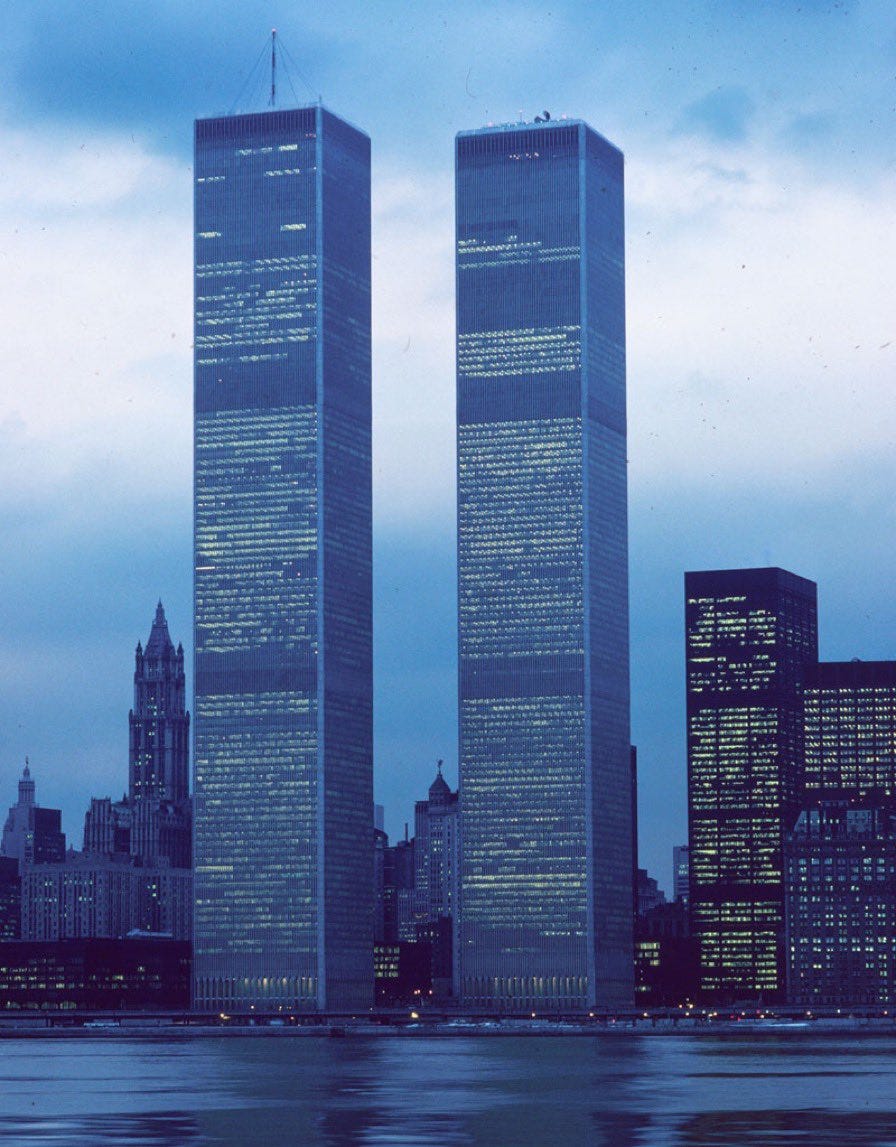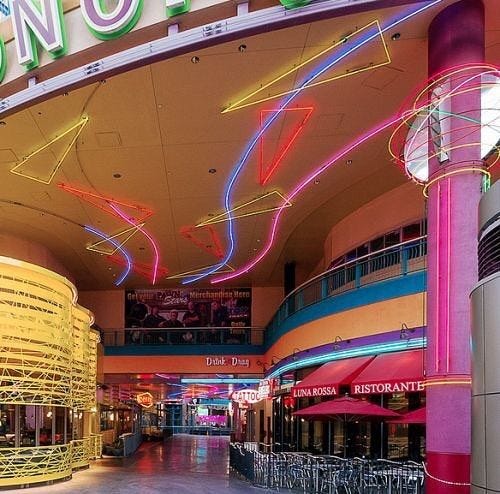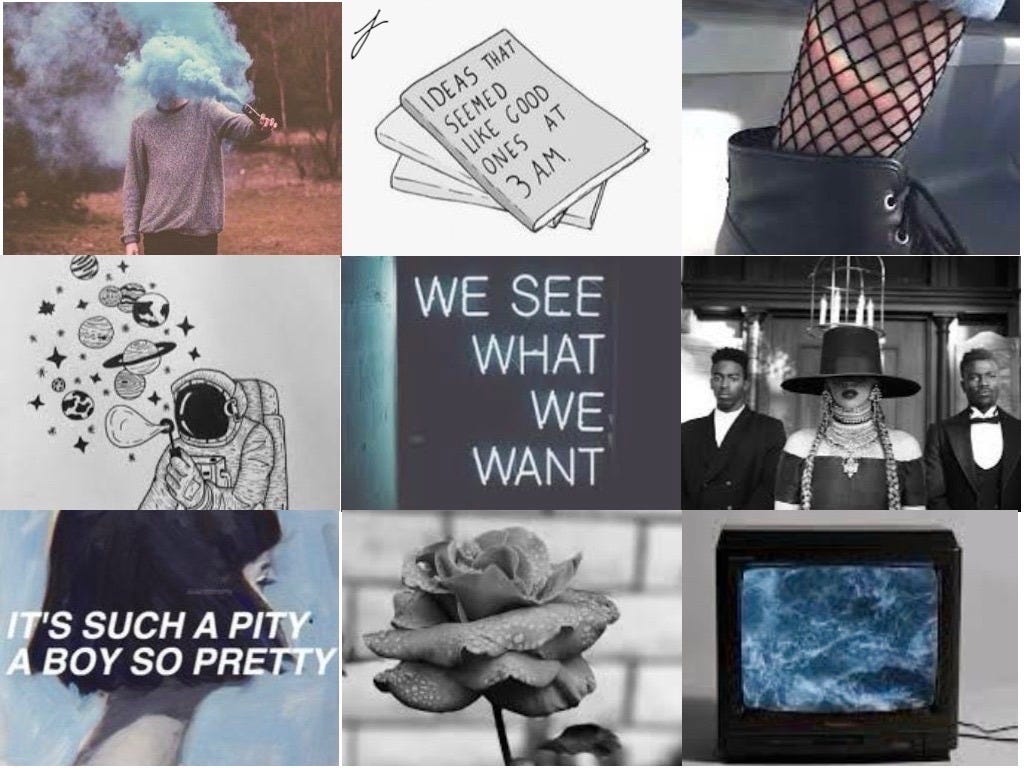Today's Capitalism Has No Aesthetic
20th century finance had an aesthetic. Platform capitalism has made our culture aesthetically incoherent.
In this article, I will argue that the Reagan-era yuppie represented a more coherent cultural figure than today’s fragmented tech-bro identity.
Secondly, I will argue that the aesthetic coherence of previous decades has been replaced by fragmented micro-cultures shaped by algorithmic churn.
Lastly, I will argue that our current nostalgia for retro corporate design reflects a deeper longing for a lost cultural grammar and sense of historical continuity.
The capitalism of the 80s, marked by big finance, had a unified aesthetic. Today’s tech-bro capitalism has no shared aesthetic.
The twin towers represent a bygone era of late 20th century, yuppie capitalism.
The young, urban professionals of the Reagan-era just had such a great pastiche, far superior to the silicon valley, platform capitalists of today.
The neon-and-chrome malls, Memphis design, VHS fuzz, and genre-bending pop culture of the 80s and 90s was critiqued at the time as being highly ironic and commodified.
Frederich Jameson argued in the late 90s that the aesthetic of capitalism was playing with signs detached from meaning. Think of shopping malls with mock-Roman columns.
However, at least the 80s offered a shared visual grammar at all… Today, the cultural aesthetic is so fragmented, broken up into micro-aesthetics, moodboards and subcultures, and controlled by algorithmic churn on tech platforms.
I like to think the destruction of the World Trade Center in 2001 symbolized a shift in the economy - in which the most powerful locus of capitalism moved from wall street to silicon valley.
We went from the stockbroker to the tech-bro…
Silicon Valley did a great job of co-opting the critiques of capitalism stemming from 1960s counterculture, which emphasized autonomy, creativity, and non-hierarchical organization.
This makes the exploitation less obvious. The techno-lords now wear plain tees and not Italian suits. They talk about decentralized platforms… neglecting to mention that the rent is due…
Today’s exploitation under capitalism is harder to identify because it’s disguised as freedom - freelance gigs, personal brands, and self-improvement - These all mask structures of control and extraction.
This also meant the shared aesthetic of capitalism died too. It went underground, but unlike the exploitation, it was dead and buried there.
Jameson further pointed out that capitalism removes us from any linear historical timeline and is instead a constant recycling of history. However, I believe this recycling has since become incoherent.
I think the 90s was the last decade where you could feel situated in a historical time.
You have probably thought before that, until the 00s, each decade had its own unique look and feel. For example, if you watch a movie from 2005, there is much less to give away what era it is from.
The importance of a society’s aesthetics is that it makes us look forwards to something. It allows us to imagine the future.
Today’s culture is fragmented and ironic. There are no cohesive aesthetic projects. Ergo, it has a kind of flatness to it. It is without color or depth.
And so, we also have nothing to look forward to…
For these reasons - without a coherent vision of capitalism - it is harder to be caught in the mania of profit. Participating in the system is pointless when there is no agreed upon destination.
(A moodboard on Tumblr is the closest thing my generation has to a unified aesthetic grammar.)
A major contributing factor to today’s fragmented culture is algorithmic churn. Music, film and media has always succeeded on the basis of what makes money - but in today’s world of social media - we have the added motive of what brings engagement.
Engagement on social media prioritizes immediacy, recognizability, and shareability over coherence or depth. Not to mention, there is much less concern for originality in short-form content. Creators happily copy the success of others in ways that would have meant a lawsuit in traditional media.
On the radio, the lifespan of a hit could be months. On social media, posts typically get engagement for a few weeks before petering out. The algorithm churns at a much higher rate than traditional media.
This speeding up of the cultural cycle can only add to the sense of disorientation and loss of historical consciousness. In the rapids of cultural acceleration, many cling to the micro-cultures they do recognize, fragmenting things even further.
There are people in the 20s who already feel out of touch, alienated from the cultural present, feeling too old to be with it.

For this reason, despite the yuppie aesthetic of the 80s being commodified, neutral in style, and cheaply imitating bygone history… at least it was some kind of unified, cultural expression.
Our nostalgia for a shared visual grammar is probably why large corporations, like Pepsi, Pizza Hut have revived their retro, corporate aesthetics. TikTok is also full of corporate glamorization and “old money aesthetic”.
This yearning for a unified aesthetic under capitalist is everywhere.







